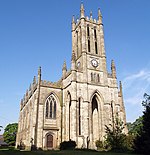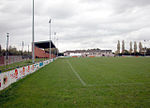Besses United Reformed Church
Alfred Waterhouse buildingsBesses o' th' BarnChurches in Greater ManchesterGothic Revival church buildings in Greater ManchesterGrade II listed churches in the Metropolitan Borough of Bury ... and 1 more
United Reformed churches in England

Besses United Reformed Church is designated a Grade II building by Historic England. It is situated between Bury New Road and Bury Old Road at Besses o' th' Barn, an area of Whitefield, Greater Manchester, England.
Excerpt from the Wikipedia article Besses United Reformed Church (License: CC BY-SA 3.0, Authors, Images).Besses United Reformed Church
Morley Street,
Geographical coordinates (GPS) Address Nearby Places Show on map
Geographical coordinates (GPS)
| Latitude | Longitude |
|---|---|
| N 53.549144444444 ° | E -2.2939388888889 ° |
Address
Morley Street
Morley Street
M45 6QA , Besses o' th' Barn
England, United Kingdom
Open on Google Maps








